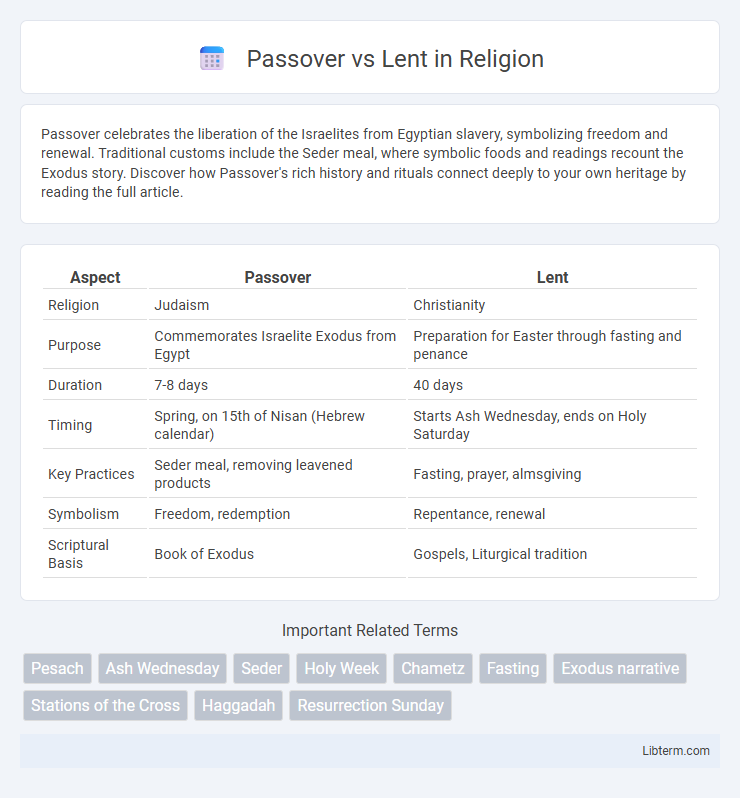Passover celebrates the liberation of the Israelites from Egyptian slavery, symbolizing freedom and renewal. Traditional customs include the Seder meal, where symbolic foods and readings recount the Exodus story. Discover how Passover's rich history and rituals connect deeply to your own heritage by reading the full article.
Table of Comparison
| Aspect | Passover | Lent |
|---|---|---|
| Religion | Judaism | Christianity |
| Purpose | Commemorates Israelite Exodus from Egypt | Preparation for Easter through fasting and penance |
| Duration | 7-8 days | 40 days |
| Timing | Spring, on 15th of Nisan (Hebrew calendar) | Starts Ash Wednesday, ends on Holy Saturday |
| Key Practices | Seder meal, removing leavened products | Fasting, prayer, almsgiving |
| Symbolism | Freedom, redemption | Repentance, renewal |
| Scriptural Basis | Book of Exodus | Gospels, Liturgical tradition |
Origins: Tracing the Roots of Passover and Lent
Passover originates from ancient Jewish traditions commemorating the Exodus from Egypt around 1300 BCE, symbolizing liberation and divine intervention. Lent stems from early Christian practices established in the 4th century CE, reflecting Jesus Christ's 40-day fasting in the desert before Easter. Both observances emphasize spiritual renewal through fasting, prayer, and reflection, rooted in distinct religious histories and theological foundations.
Historical Significance and Evolution
Passover originates from ancient Jewish traditions commemorating the Exodus from Egypt, symbolizing liberation and divine intervention, dating back over 3,000 years. Lent evolved from early Christian practices of fasting and penance, reflecting 40 days of preparation before Easter to emulate Jesus' 40 days in the wilderness. Both observances have transformed over centuries, with Passover maintaining core ritual elements like the Seder meal, while Lent's rituals vary widely across Christian denominations, highlighting their distinct historical and theological trajectories.
Core Beliefs and Religious Symbolism
Passover centers on the Jewish exodus from Egypt, symbolizing liberation and divine salvation through the sacrifice of the Passover lamb and the eating of matzah, which represents both suffering and redemption. Lent, observed by Christians, commemorates the 40 days Jesus spent fasting in the desert, emphasizing repentance, sacrifice, and spiritual renewal through practices like fasting, prayer, and almsgiving. Both observances use symbolic rituals to reflect themes of deliverance and transformation within their respective faith traditions.
Key Rituals and Observances
Passover centers on the Seder meal featuring symbolic foods such as matzah, bitter herbs, and charoset, alongside the retelling of the Exodus story, while Lent emphasizes fasting, prayer, and almsgiving as acts of penance and reflection. Key Passover rituals include removing chametz, reciting the Haggadah, and eating unleavened bread to commemorate liberation from slavery. Lent rituals involve abstaining from certain foods, attending church services, and observing Ash Wednesday and Holy Week to prepare for Easter.
Duration and Timing in the Religious Calendar
Passover typically lasts for seven or eight days, beginning on the 15th day of the Hebrew month of Nisan, which usually falls in March or April. Lent spans 40 days, starting on Ash Wednesday and ending on Holy Saturday, preceding Easter Sunday, occurring in late winter or early spring. Both observances align with the spring season but differ significantly in length and placement within their respective religious calendars.
Dietary Restrictions and Traditional Foods
Passover dietary restrictions center on avoiding chametz, leavened products, symbolizing the haste of the Israelites' exodus, with traditional foods like matzah, bitter herbs, and charoset representing hardship and hope. Lent dietary practices in Christian traditions often include fasting or abstaining from meat on Fridays, symbolizing penance and sacrifice, with simple meals such as fish, legumes, and vegetables being customary. Both observances emphasize symbolic foods that reflect their respective spiritual themes--freedom and purification for Passover, and penance and reflection during Lent.
Family and Community Gatherings
Passover and Lent both emphasize family and community gatherings as central to their observances, fostering unity and shared spiritual reflection. Passover includes a Seder meal where families recite the Haggadah, reinforcing Jewish identity and collective history, while Lent encourages communal worship, fasting, and acts of charity that strengthen bonds within Christian communities. These rituals serve as vital opportunities for intergenerational connection and cultural continuity in Jewish and Christian traditions.
Themes of Sacrifice, Redemption, and Renewal
Passover centers on the sacrifice of the Passover lamb and the liberation of the Israelites from Egyptian slavery, symbolizing redemption and divine deliverance. Lent emphasizes spiritual renewal through fasting, repentance, and reflection on the sacrifice of Jesus Christ for humanity's salvation. Both observances highlight themes of sacrifice, redemption, and renewal, underscoring a transformative journey toward freedom and spiritual restoration.
Modern Practices and Adaptations
Modern Passover practices emphasize family gatherings and symbolic meals like the Seder, often incorporating contemporary themes such as social justice and environmental awareness. Lent adaptations include personalized fasting alternatives, digital devotionals, and community service projects, reflecting diverse spiritual needs and lifestyles. Both traditions maintain core rituals while embracing flexibility to engage younger generations and global communities.
Comparative Insights: Spiritual and Cultural Impact
Passover commemorates the Jewish liberation from Egyptian slavery, emphasizing themes of freedom, family, and historical remembrance, while Lent in Christianity centers on repentance, fasting, and spiritual renewal leading to Easter. Both observances profoundly shape their communities' cultural identities through rituals: Passover's Seder meal fosters communal storytelling, whereas Lent's practices encourage personal reflection and sacrifice. The spiritual impact of Passover reinforces collective memory and resilience, contrasting with Lent's focus on individual transformation and preparation for resurrection.
Passover Infographic

 libterm.com
libterm.com